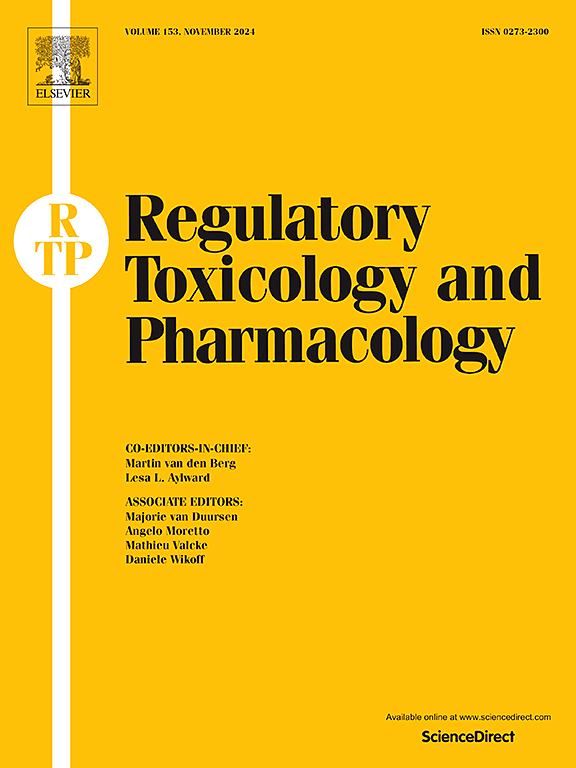HESI GTTC ring trial: Concordance between Ames and rodent carcinogenicity outcomes for N-nitrosamines (NAs) with rat and hamster metabolic conditions
IF 3
4区 医学
Q1 MEDICINE, LEGAL
引用次数: 0
Abstract
A multi-sector study (i.e., Ring Trial) was designed to improve the in vitro detection of N-nitrosamine (NA)-associated mutagenicity by optimizing the bacterial reverse mutation (i.e., Ames) assay protocol and testing various conditions on the sensitivity and specificity for the prediction of rodent carcinogenicity. A total of 29 NAs and 3 N-nitroso drug-like compounds from different structural classes and carcinogenicity outcomes were tested (two independent laboratories per compound) across 5 bacterial strains using a 30-min pre-incubation protocol. To evaluate the impact of different metabolic activating systems (MASs), testing conditions included the use of 10 or 30 % liver S9 fractions prepared from rats or hamsters pretreated with inducers of enzymatic activity. Results indicate that E. coli and Salmonella typhimurium strains detecting single base pair mutations, coupled with MASs containing 30 % hamster S9s were the most sensitive (90 %) for identifying NAs that are rodent carcinogens. Regarding MAS combinations, the highest sensitivity was 30 % rat and 30 % hamster (93 %), but has low specificity (45 %), with good laboratory agreement for the Ames calls (91 %). DMSO and water were considered suitable solvents, except for small-molecular weight alkyl NAs. These results will support harmonized Ames testing of NAs, giving high confidence for a negative result.

HESI GTTC环试验:n -亚硝胺(NAs)致癌性结果与大鼠和仓鼠代谢状况的一致性
为了提高n -亚硝胺(N-nitrosamine, NA)相关致突变性的体外检测水平,我们设计了一项多部门研究(即Ring Trial),通过优化细菌反向突变(即Ames)检测方案,并测试各种条件对预测啮齿动物致癌性的敏感性和特异性。采用30分钟的孵育前方案,在5种菌株中测试了来自不同结构类别的29种NAs和3种n -亚硝基药物样化合物及其致癌性结果(每种化合物两个独立实验室)。为了评估不同代谢激活系统(MASs)的影响,测试条件包括使用用酶活性诱导剂预处理的大鼠或仓鼠制备的10%或30%的肝脏S9组分。结果表明,检测到单碱基对突变的大肠杆菌和鼠伤寒沙门菌,加上含有30%仓鼠S9s的MASs,对鉴定鼠致癌物NAs最敏感(90%)。对于MAS组合,最高敏感性为30%大鼠和30%仓鼠(93%),但特异性较低(45%),对Ames呼叫具有良好的实验室一致性(91%)。DMSO和水被认为是合适的溶剂,除了小分子量的烷基NAs。这些结果将支持NAs的统一Ames检测,为阴性结果提供高可信度。
本文章由计算机程序翻译,如有差异,请以英文原文为准。
求助全文
约1分钟内获得全文
求助全文
来源期刊
CiteScore
6.70
自引率
8.80%
发文量
147
审稿时长
58 days
期刊介绍:
Regulatory Toxicology and Pharmacology publishes peer reviewed articles that involve the generation, evaluation, and interpretation of experimental animal and human data that are of direct importance and relevance for regulatory authorities with respect to toxicological and pharmacological regulations in society. All peer-reviewed articles that are published should be devoted to improve the protection of human health and environment. Reviews and discussions are welcomed that address legal and/or regulatory decisions with respect to risk assessment and management of toxicological and pharmacological compounds on a scientific basis. It addresses an international readership of scientists, risk assessors and managers, and other professionals active in the field of human and environmental health.
Types of peer-reviewed articles published:
-Original research articles of relevance for regulatory aspects covering aspects including, but not limited to:
1.Factors influencing human sensitivity
2.Exposure science related to risk assessment
3.Alternative toxicological test methods
4.Frameworks for evaluation and integration of data in regulatory evaluations
5.Harmonization across regulatory agencies
6.Read-across methods and evaluations
-Contemporary Reviews on policy related Research issues
-Letters to the Editor
-Guest Editorials (by Invitation)

 求助内容:
求助内容: 应助结果提醒方式:
应助结果提醒方式:


